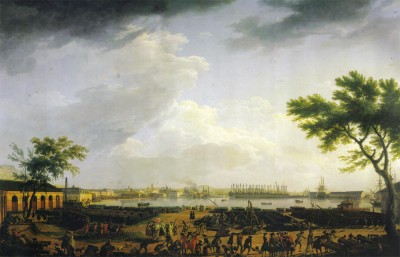VIEW OF THE ‘PONT-NEUF’ FROM THE CORNER OF THE ORDNANCE STORES
By Joseph Vernet, 1755
By 1750 France had only three working dry docks and none of them answered the growing needs of the French Marine. The double dock at Rochefort could not be accessed by any ship larger than the fourth rate because its position was too far up the narrow and winding Charente river, and the only other dry dock, that at Brest, had been poorly designed and would not dry out completely. There was a fabulous harbor and yard at Toulon in the Mediterranean, the subject of this picture but the Mediterranean is tideless which makes the design of dry docks extremely difficult. With no tide a dry dock cannot drain itself but must be pumped out, and it was not until 1774 that the Spanish solved the problem in their dockyard at Cartagena by installing a steam-driven pump. In the meantime French ships had to be careened – effectively pulled on their sides to expose their hulls. Moreover French ships had been built to escort merchantmen or capture enemy merchant ships rather than for fleet battles which were soon to be forced on them time and again by the resurgent Royal Navy.
This shows the ordnance stores of the Toulon dockyard. Lines of battleships are moored in the background, and in the foreground shot of every caliber are perfectly aligned. Some cannon are being cleaned while a group of officers and engineers hold a discussion.
